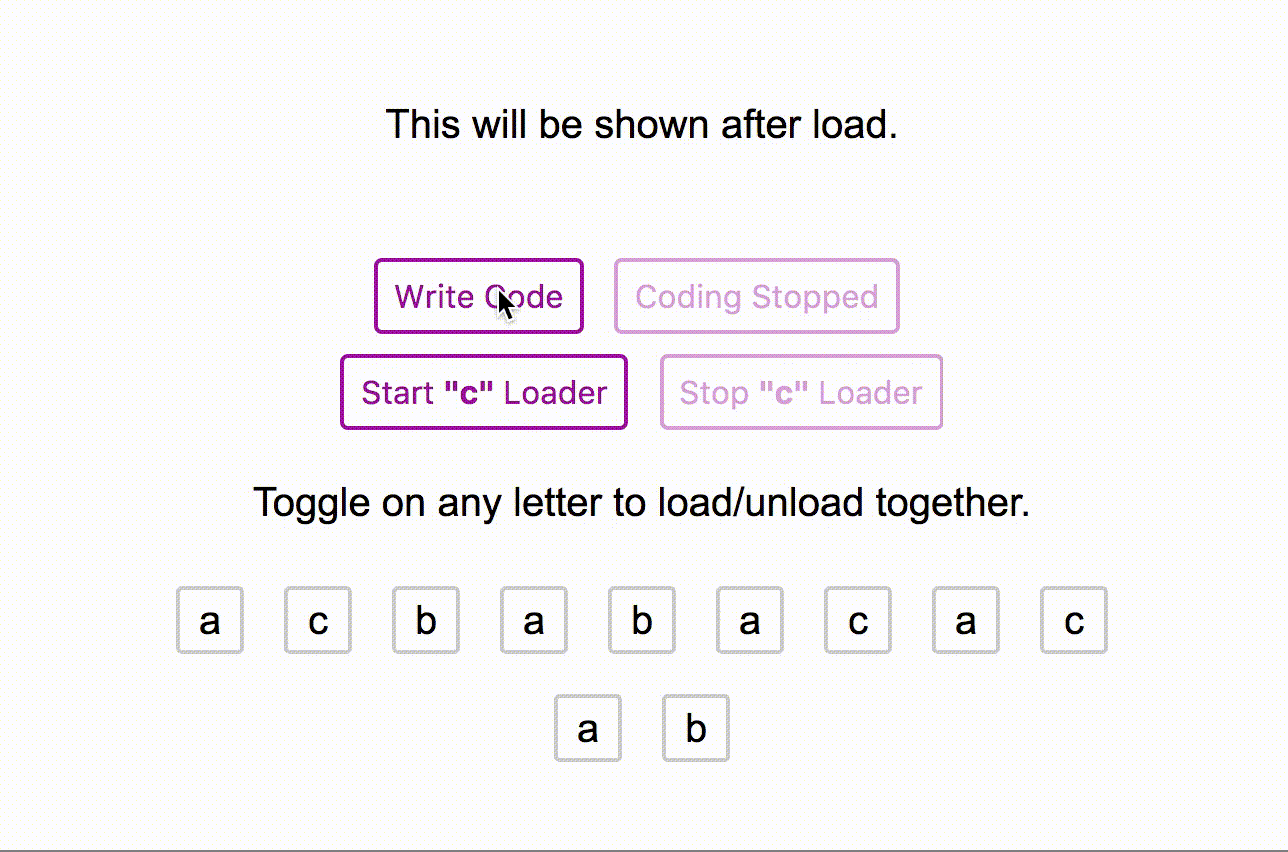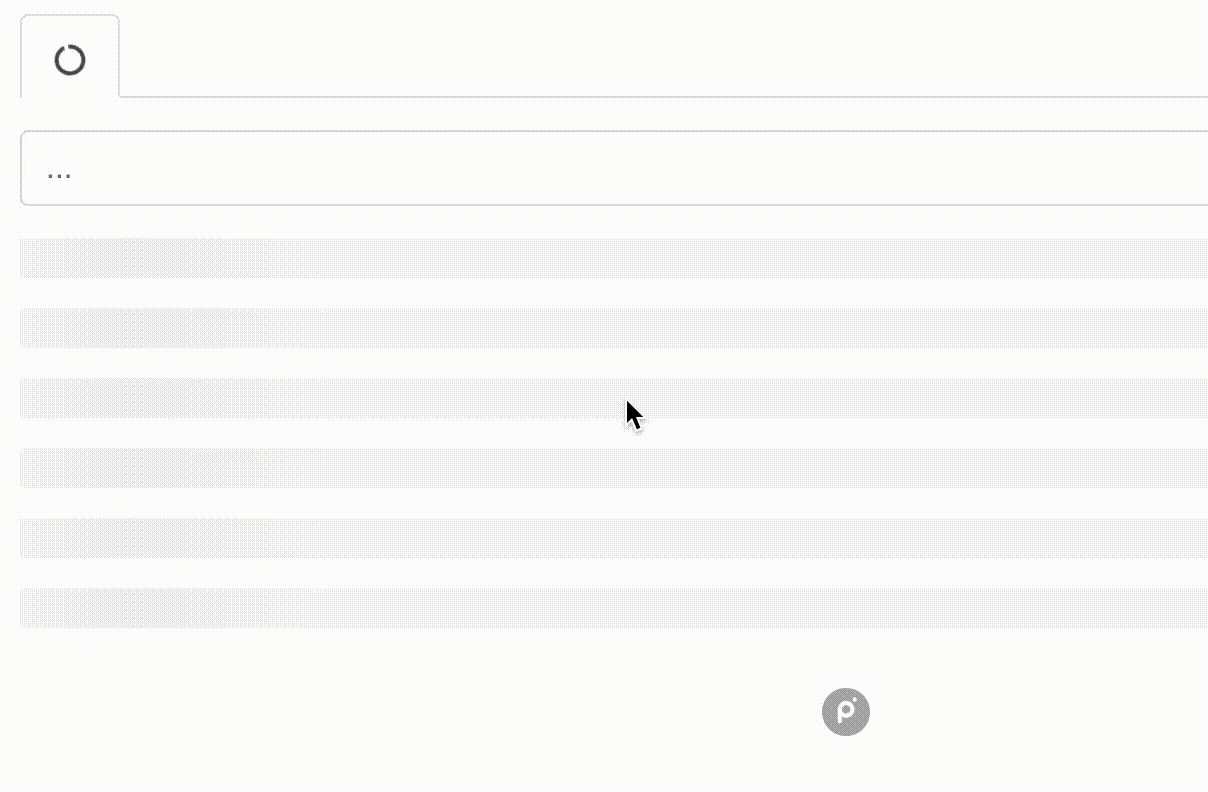Multiple Process Loader Management for Vue and (optionally) Vuex.
Even it's named as "vuex-loading", Vuex is now completely optional.
vuex-loading helps to manage multiple loading states on the page without any conflict. It's based on a very simple idea that manages a Vuex store with multiple loading states. The built-in loader component listens its registered loader and immediately become loading state.
- Vue.js (v2.0.0+)
- Vuex, optionally (v2.0.0+)
$ npm install vuex-loading
# or if you using Yarn
$ yarn add vuex-loadingimport VueLoading from 'vuex-loading'
Vue.use(VueLoading) // add VueLoading as Vue pluginThen you should register VueLoading module:
new Vue({
el: '#app',
store,
vueLoading: new VueLoading({registerComponents: false}), // configure VueLoading here
});Simply set useVuex parameter to true and optionally override
moduleName
import VueLoading from 'vuex-loading'
Vue.use(Vuex)
Vue.use(VueLoading) // add VueLoading as Vue pluginThen you should register vueLoading module:
new Vue({
el: '#app',
store,
vueLoading: new VueLoading({ useVuex: true, moduleName: 'vuex-example-module' }), // configure VueLoading here
});Now VueLoading will use Vuex store for data management
which can be traced in Vue DevTools
You can use this options for customize VueLoading behavior
boolean value, false by default, use this value for enabling
integration with Vuex store
When this value is true VueLoading will store data in Vuex store
and all changes to this data will be made by dispatching actions to store
string value, loading by default.
Name for Vuex store if useVuex set to true, otherwise not used.
boolean value, true by default, register v-loading components.
vuex-loading provides some helpers to you to use in your templates. All features can be obtained from $vuexLoading property in Vue components
Returns boolean value if any loader exists in page.
<template>
<progress-bar v-if="$vuexLoading.anyLoading">Please wait...</progress-bar>
</template>Returns boolean value if given loader exists in page.
<template>
<progress-bar v-if="$vuexLoading.isLoading('creating user')">Creating User...</progress-bar>
</template>Returns boolean value if some of given loaders exists in page.
<template>
<progress-bar v-if="$vuexLoading.isLoading(['creating user', 'page loading'])">Creating User...</progress-bar>
</template>Starts the given loader.
<template>
<button @click="$vuexLoading.startLoading('creating user')">Create User</button>
</template>Stops the given loader.
<template>
<button @click="$vuexLoading.endLoading('creating user')">Cancel</button>
</template>vuex-loading provides some helpers to you to use in your Vuex stores.
import { createActionHelpers } from 'vuex-loading'
const { startLoading, endLoading } = createActionHelpers({
moduleName: 'loading'
});You can trigger loader from the action. This will make your templates cleaner and you will have an accurate loader status.
startLoading will trigger a loading and will end loader after the optional async callback is finished.
Example using the Promise returning callback function
export default {
actions: {
async createUser({ commit, dispatch }) {
const response = await startLoading(dispatch, 'creating user', () => {
return fetch("...") // Some async job that returns Promise instance.
});
commit(types.CREATE_USER, response)
}
},
// ...
}Example call without a provided callback
export default {
actions: {
createUser({ commit, dispatch }) {
startLoading(dispatch, 'creating user');
request('/create-user', (response) => {
endLoading(dispatch, 'creating user')
commit(types.CREATE_USER, response);
});
}
},
// ...
}Ends given loading from actions.
export default {
actions: {
async createUser({ commit, dispatch }) {
try {
const response = await startLoading(dispatch, 'creating user', () => { /* ... */ });
commit(types.CREATE_USER, response)
} catch (e) {
// In any unexpected thing occurs on runtime, end the loading.
endLoading(dispatch, 'creating user')
}
}
},
// ...
}If you disable registerComponents option then
import and add v-loading into components
import vLoading from 'vuex-loading/v-loading.vue'
components: {
'v-loading': vLoading
}In template, you should wrap your content with v-loading component to show loading on it.
<v-loading loader='fetching data'>
<template slot='spinner'>
This will be shown when "fetching data" loader starts.
</template>
This will be shown when "fetching data" loader ends.
</v-loading>Better example for a button with loading state:
<button :disabled='$loading.isLoading("creating user")'>
<v-loading loader='creating user'>
<template slot='spinner'>Creating User...</template>
Create User
</v-loading>
</button>With reusable loader components, you will be able to use custom loader components as example below. This will allow you to create better user loading experience.
In this example above, the tab gets data from back-end, and the table loads data from back-end at the same time. With vuex-loading, you will be able to manage these two seperated loading processes easily:
<template lang='pug'>
div
v-loading(loader='fetching tabs')
template(slot='spinner')
b-tabs
template(slot='tabs')
b-nav-item(active disabled)
v-icon(name='circle-o-notch', spin)
b-tabs
template(slot='tabs')
b-nav-item(v-for='tab in tabs') {{ tab.name }}
v-loading(loader='fetching data')
table-gradient-spinner(slot='spinner')
table
tr(v-for='row in data')
// ...
</template>You may want to design your own reusable loader for your project. You better create a wrapper component called my-spinner:
<!-- MySpinner.vue -->
<i18n>
tr:
loading: Yükleniyor...
en:
loading: Loading...
</i18n>
<template lang="pug">
div.loading-spinner
//- Uses vue-awesome spinner
v-icon(name='refresh', spin)
span {{ $t('loading') }}
</template>
<style scoped lang="scss">
.loading-spinner {
opacity: 0.5;
margin: 50px auto;
text-align: center;
.fa-icon {
vertical-align: middle;
margin-right: 10px;
}
}
</style>Now you can use your spinner everywhere using slot='spinner' attribute:
<template lang="pug">
v-loading(loader='fetching data')
my-spinner(slot='spinner')
div
p My main content after fetching data...
</template>Also you can use built in loaders:
v-loading-spinnerv-loading-heart- ... more to come.
You need to put them into a template tag.
<v-loading loader='fetching data'>
<template slot="spinner">
<v-loading-spinner height='30px' width='30px' />
</template>
This will be shown when "fetching data" loader ends.
</v-loading>Please see example for more detailed example.
Use npm run dev-vuex or npm run dev-default commands
for running examples locally.
- Fatih Kadir Akın, (creator)
- Igor, (maintainer, made Vuex-free)
MIT © Fatih Kadir Akın

